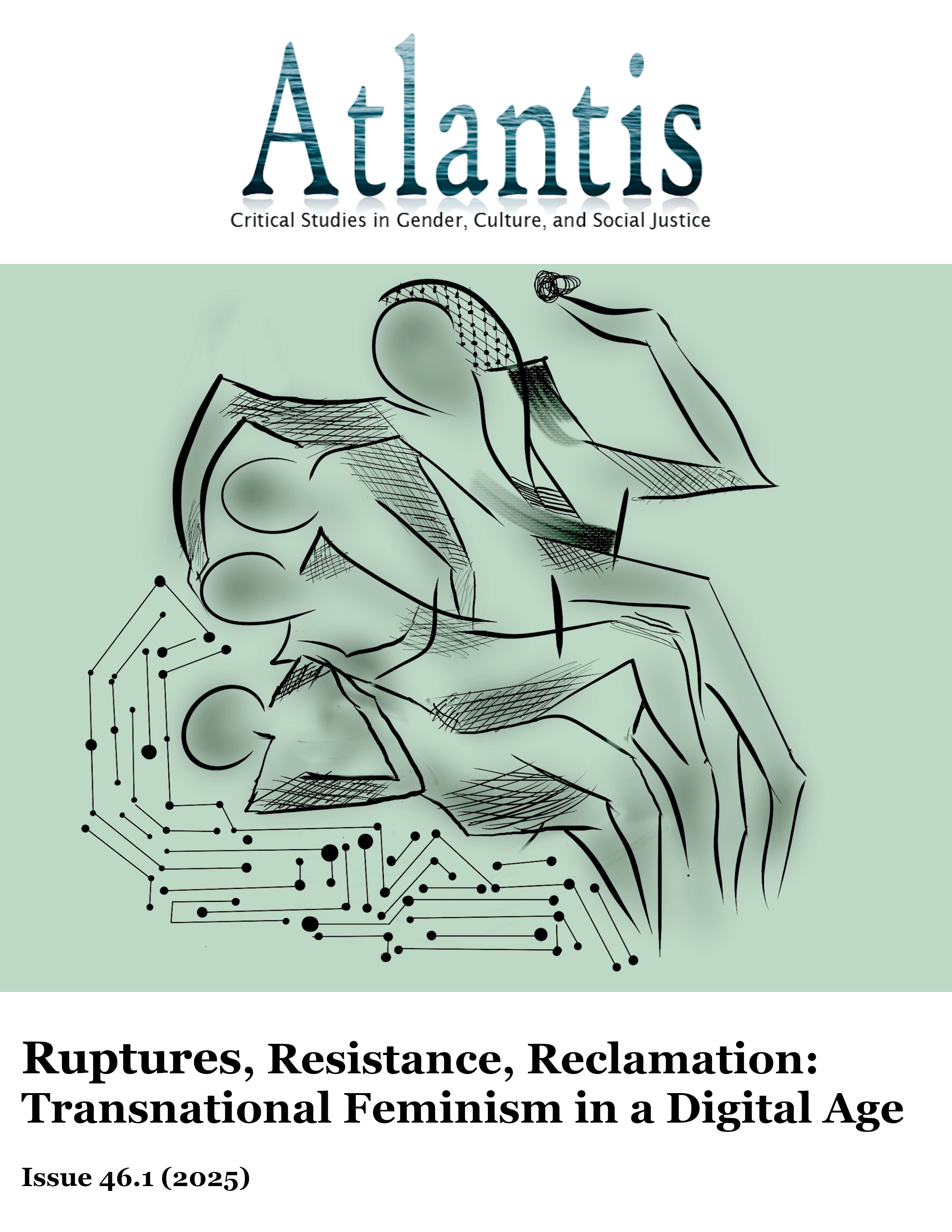The Banality of a Medium
Iran’s “Woman, Life, Freedom” Movement in the Social Media Mirror
Keywords:
counter-hegemony, hegemony, hyperreality, Iranian women, social media, veiling discourses, Women, Life Freedom MovementAbstract
The tragic death of Zhina (Mahsa) Amini in September 2022 sparked the largest national movement in Iran since 2009. Iranian Women became the symbolic center and main actors of this movement, with the Kurdish slogan “Woman, Life, Freedom” emerging as its defining motto.. This paper presents a theoretical and exploratory reflection on the “Woman, Life, Freedom” (WLF) movement, focusing on how social media, as a medium, shaped its mainstream representations and trajectory. After a brief genealogical analysis of discourses that place women’s veiling at the core of Iranian national politics, the paper examines how the hyperreal nature of modern reality influences social movements. It argues that social media amplifies the visibility of “hyperreal political subjects,” making them dominant actors in the movement. This transformation of political subjectivity imposed the structural limitation of social media not only on representation but also on the “presence” of political actions. Finally, the paper explores how social media facilitates revolutionary and polarized political strategies, enabling the dismantling of dominant hegemonies while simultaneously discouraging radical and progressive political imagination in building counter-hegemonic discourses.
References
Abrahamian, Ervand. 2008. A History of Modern Iran. Cambridge: Cambridge University Press.
Agamben, Giorgio. 1995. Homo Sacer: Sovereign Power and Bare Life. Translated by Daniel Heller-Roazen. Stanford: Stanford University Press.
Ahmed, Leila. 1992. Women and Gender in Islam. New Haven: Yale University Press.
Akhavan, Niki. 2013. Electronic Iran: The Cultural Politics of an Online Evolution. New Jersey: Rutgers University Press.
Al-Ali, Nadje, and Isabel Käser. 2022. “Beyond Feminism? Jineolojî and the Kurdish Women’s Freedom Movement.” Politics & Gender 18(1): 212-243.
Alimardani, Mahsa, and Stefania Milan. 2018. “The Internet as a Global/Local Site of Contestation: The Case of Iran.” In Global Cultures of Contestation, edited by Esther Peeren et al., 171-192. Palgrave Studies in Globalization, Culture and Society.
Bakshy, Eytan, Solomon Messing, and Lada A. Adamic. 2015. “Exposure to Ideologically Diverse News and Opinion on Facebook.” Science 348(6239): 1130-1132.
Barberá, Pablo. 2020. “Social Media, Echo Chambers, and Political Polarization.” In Social Media and Democracy: The State of the Field, Prospects for Reform, edited by Nathaniel Persily and Joshua A. Tucker, 34-55. Cambridge University Press.
Baudrillard, Jean. 1994. Simulacra and Simulation.Ann arbor: University of Michigan Press.
Bayat, Asef. 2023. “Is Iran on the Verge of Another Revolution?” Journal of Democracy 34(2): 19-31.
Bourdieu, Pierre. 1984. Distinction: A Social Critique of the Judgement of Taste. Translated by Richard Nice. Cambridge: Harvard University Press.
Campbell, Charles. 2021. “Simulation, Fetishism and World Domination: Using Baudrillard to Analyse American Discourse.” Critical Survey 33(3-4): 16-27.
Collins, Patricia Hill. 1986. “Learning from the Outsider Within: The Sociological Significance of Black Feminist Thought.” Social Problems 33(6): s14-s32.
Corey, Paul. 2022. “World War IV and the COVID Apocalypse.” In Making Sense of Diseases and Disasters: Reflections of Political Theory from Antiquity to the Age of COVID, edited by Lee Trepanier. 25-39. New York: Routledge.
Dabashi, Hamid. 2016. Iran without Borders: Towards a Critique of the Postcolonial Nation. London: Verso Books.
Debord, G. 2002. The Society of the Spectacle. Canberra. Hobgoblin Press.
Düzgün, Meral. 2016. “Jineology: The Kurdish Women’s Movement.” Journal of Middle East Women's Studies 12(2): 284-287.
Ehteshami, Anoushiravan. 2017. Iran: Stuck in Transition. Abingdon, Oxon: Routledge.
Fisher, Eran. 2015. “How Less Alienation Creates More Exploitation? Audience Labour on Social Network Sites.” In Marx in the Age of Digital Capitalism, edited by Christian Fuchs and Vincent Mosco, 180-203. Leiden: Brill.
Ganji, Akbar. 2022. “The Relationship between the Use of Male and Female Sexual Organs as Sexist Violence and Slur with the Slogan of ‘Women, Life, Freedom.’” Gooya News. November 14, 2022. https://news.gooya.com/2022/11/post-70336.php.
Ghaffari, Soudeh. 2022. “Discourses of Celebrities on Instagram: Digital Femininity, Self-Representation and Hate Speech.” Critical Discourse Studies 19(2): 161-178.
Gladwell, Malcolm. 2010. “Small Change: Why the Revolution Will Not Be Tweeted.” The New Yorker. October 4.
Gramsci, Antonio. 1992. Selections from the Prison Notebooks. Edited and translated by Quintin Hoare and Geoffrey Nowell-Smith. London: Lawrence & Wishart.
Greenwood, Dara N. 2013. “Fame, Facebook, and Twitter: How Attitudes about Fame Predict Frequency and Nature of Social Media Use.” Psychology of Popular Media Culture 2(4): 222-236.
Habermas, Jürgen. 1991. The Structural Transformation of the Public Sphere: An Inquiry into a Category of Bourgeois Society. Cambridge: MIT Press.
Harding, Sandra. 1991. Whose Science? Whose Knowledge?: Thinking from Women’s Lives. Ithaca: Cornell University Press.
Hirschman, Nancy J. 1998. “Western Feminism, Eastern Veiling, and the Question of Free Agency.” Constellations 5(3): 345-368.
Hoodfar, Homa, and Ana Ghoreishian. 2012. “Morality Policing and the Public Sphere: Women Reclaiming Their Bodies and Their Rights.” In Sexuality in Muslim Contexts: Restrictions and Resistance, edited by Anissa Helie and Homa Hoodfar, 234-268. New York: Zed Books.
Khosravi, Shahram. 2008. Young and Defiant in Tehran. Philadelphia: University of Pennsylvania Press.
Lugones, Maria. 2013. “The Coloniality of Gender.” In Globalization and the Decolonial Option, edited by Walter D. Mignolo and Arturo Escobar, 369-390. New York: Routledge.
Mahdavi, Mojtaba. 2023. “Iran: A Post-Islamist Society Revolts Against an Islamist State.” Socialist Project. February 22, 2023.
Mahdavi, Pardis. 2008. Passionate Uprisings: Iran’s Sexual Revolution. Stanford: Stanford University Press.
Manoukian, Setrag. 2011. “Two Forms of Temporality in Contemporary Iran.” Sociologica (3): 1-17.
Marx, Karl. 2004. Capital: Volume I. London: Penguin UK.
Matin, Kamran. 2022. “Decolonising Iran: A Tentative Note on Inter-Subaltern Colonialism.” Current Anthropology 63(2): 231-249. doi.org/10.1086/719886.
Matin-Asgari, Afshin. 2018. Both Eastern and Western: An Intellectual History of Iranian Modernity. Cambridge: Cambridge University Press.
McLuhan, Marshall. 2006. “The Medium is the Message.” In Media and Cultural Studies: Keyworks, edited by Meenakshi Gigi Durham and Douglas M. Kellner, 107-117. Malden: Blackwell Publishing.
Moaveni, A. 2007. Lipstick Jihad: A Memoir of Growing up Iranian in America and American in Iran. PublicAffairs.
Morozov, Evgeny. 2012. The Net Delusion: The Dark Side of Internet Freedom. Cambridge, MA: Perseus Books.
Mortensen, Mette. 2011. “When Citizen Photojournalism Sets the News Agenda: Neda Agha Soltan as a Web 2.0 Icon of Post-Election Unrest in Iran.” Global Media and Communication 7(1): 4-16.
Naghibi, Nima. 2007. Rethinking Global Sisterhood: Western Feminism and Iran. Minnesota: University of Minnesota Press.
_____. 1999. “Bad Feminist or Bad-Hejabi? Moving Outside the Hejab Debate.” Interventions: International Journal of Postcolonial Studies 1(4): 555-571.
Nagle, A. 2017. Kill All Normies: Online Culture Wars from 4chan and Tumblr to Trump and the Alt-Right. Winchester: John Hunt Publishing (Zero Books).
Najmabadi, Afsaneh. 2006. “Beyond the Americas: Are Gender and Sexuality Useful Categories of Analysis?” Journal of Women’s History 18(1): 11-21.
_____. 1991. “Hazards of Modernity and Morality: Women, State and Ideology in Contemporary Iran.” In Women, Islam and the State, edited by Deniz Kandiyoti, 48-76. London: Palgrave Macmillan.
Paidar, Parvin. 1995. Women and the Political Process in Twentieth-Century Iran. Vol. 1. Cambridge: Cambridge University Press.
Pradhana, G. A., and S. Tania. 2021. “Hyperreality of #BlackLivesMatter Movement on Social Media.” Journal Komunikasi: Malaysian Journal of Communication 37(3): 288-303.
Sadeghi, Fatemeh. 2023. From Women’s Revolution to Jiyanist Democracy. Translated by Seteareh Shohadaei. Journal of Middle East Women's Studies 19(3): 458-468. doi.org/10.1215/15525864-10815679.
_____. 2008. “Negotiating with Modernity: Young Women and Sexuality in Iran.” Comparative Studies of South Asia, Africa and the Middle East 28(2): 250-259.
Schäfers, Marlene, and Brecht. 2017. “Jineology: From Women’s Struggles to Social Liberation.” Roar Magazine 25 November.
Siegel, Alexandra A. 2020. “Online Hate Speech.” In Social Media and Democracy: The State of the Field, Prospects for Reform, edited by Nathaniel Persily and Joshua A. Tucker, 56-88. Cambridge: Cambridge University Press.
Smith, D.E., 2005. Institutional Ethnography: A Sociology for People. Walnut Creek: Rowman Altamira.
Sunstein, Cass R. 1991. “The Law of Group Polarization.” University of Chicago Law School, John M. Olin Law & Economics Working Paper 91.
Tavakoli Targhi, Mohamad. 2002. “From Patriotism to Matriotism: A Tropological Study of Iranian Nationalism, 1870-1909.” International Journal of Middle East Studies, Special Issue: Nationalism and the Colonial Legacy in the Middle East and Central Asia 34 (2): 217-238.
Tohidi, Nayereh. 2023. “Iran in a Transformative Process by Woman, Life, Freedom.” Freedom of Thought Journal 13: 29-57.
Utz, Sonja, Martin Tanis, and Ivar Vermeulen. 2012. “It Is All About Being Popular: The Effects of Need for Popularity on Social Network Site Use.” Cyberpsychology, Behavior, and Social Networking 15(1): 37-42.
Vahabzadeh, Peyman. 2022. “ایران اتنیک ندارد” [Iran does not have an ethnicity]. PECritique, November 6, 2022. https://pecritique.com/2022/11/06/ایران-اتنیک-ندارد-پیمان-وهابزاده/
Vahdati, Soheila. 2022. “Why Does the ‘Women, Life, Freedom’ Movement Move with Insults?” Akhbar-rooz. www.akhbar-rooz.com/181532/1401/09/03/.
Van Dijck, José, and Thomas Poell. 2023. “Understanding Social Media Logic.” Media and Communication 1(1): 2-14.
Wikipedia contributors. 2024. “Death of Hadis Najafi.” Wikipedia, The Free Encyclopedia. Last modified November 14, 2024. https://en.wikipedia.org/wiki/Death_of_Hadis_Najafi.
Yardi, Sarita, and Danah Boyd. 2010. “Dynamic Debates: An Analysis of Group Polarization over Time on Twitter.” Bulletin of Science, Technology & Society 30(5): 316-327.
Yegenoglu, Meyda. 1998. Colonial Fantasies: Towards a Feminist Reading of Orientalism. Cambridge: Cambridge University Press.
YouTube. 2024. “Hadis Najafi’s Mother: My daughter was killed [in fight against mandatory] Hijab and for Mahsa Amini” YouTube. Accessed November 14, 2024. https://www.youtube.com/watch?v=h0u4HLyBDx0&t=164s.
Zahedi, Ashraf. 2007. “Contested Meaning of the Veil and Political Ideologies of Iranian Regimes.” Journal of Middle East Women’s Studies 3(3): 75-98.
Downloads
Published
Issue
Section
License
Copyright (c) 2025 Sara Naderi

This work is licensed under a Creative Commons Attribution 4.0 International License.
Authors who publish with this journal agree to the following terms:
1. Authors retain copyright and grant the journal right of first publication, with the work simultaneously licensed under a Creative Commons Attribution 4.0 International License that allows others to share the work with an acknowledgement of the work's authorship and initial publication in this journal.
2. Authors are aware that articles published in Atlantis are indexed and made available through various scholarly and professional search tools, including but not limited to Erudit.
3. Authors are able to enter into separate, additional contractual arrangements for the non-exclusive distribution of the journal's published version of the work (e.g., post it to an institutional repository or publish it in a book), with an acknowledgement of its initial publication in this journal.
4. Authors are permitted and encouraged to preprint their work, that is, post their work online (e.g., in institutional repositories or on their website) prior to and during the submission process. This can lead to productive exchanges, as well as earlier and greater citation of published work. Read more on preprints here.







